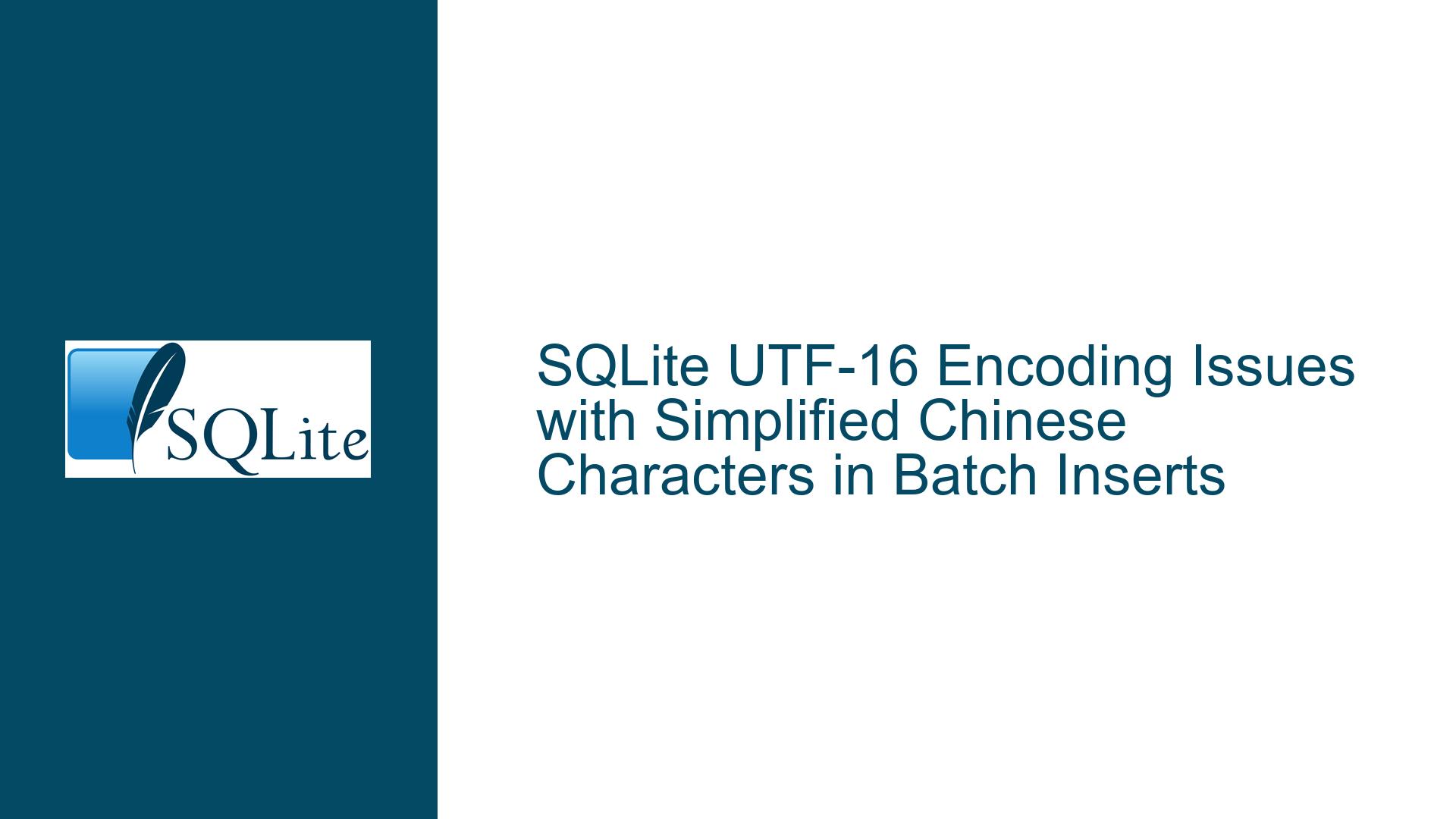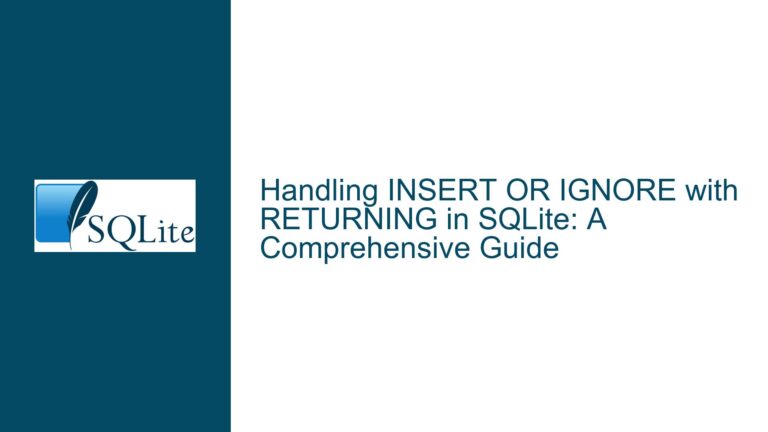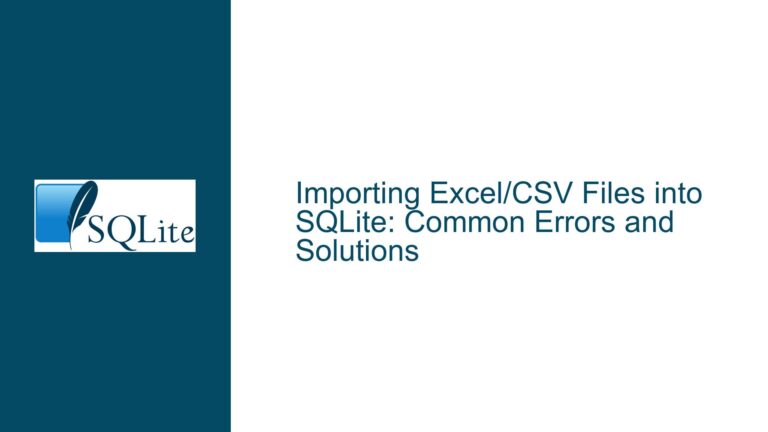SQLite UTF-16 Encoding Issues with Simplified Chinese Characters in Batch Inserts
UTF-16 Encoding Mismatch in SQLite 3.33.0 Leading to Corrupted Chinese Characters
When working with SQLite 3.33.0, a significant issue arises when attempting to insert Simplified Chinese characters into a UTF-16 encoded table. The problem manifests when executing batch insert operations via an SQL script file (import.sql) that contains Chinese characters. The characters are displayed incorrectly, appearing as question marks (????) instead of the intended text. This issue is observed in both UTF-16 Little Endian (UTF-16le) and UTF-16 Big Endian (UTF-16be) encoded tables. Interestingly, this problem does not occur in SQLite 3.10.0, where the same script executes without any issues, and the Chinese characters are displayed correctly.
The core of the issue lies in the handling of UTF-16 encoding during the batch insert process. The script file (import.sql) is encoded in ANSI, which is a single-byte encoding scheme. When SQLite 3.33.0 reads this file, it attempts to interpret the ANSI-encoded Chinese characters as UTF-16, leading to corruption. This mismatch between the encoding of the script file and the expected encoding of the database causes the characters to be misinterpreted, resulting in the display of question marks instead of the correct Chinese text.
ANSI-Encoded Script File Misinterpreted as UTF-16 in SQLite 3.33.0
The primary cause of this issue is the misinterpretation of the ANSI-encoded script file (import.sql) by SQLite 3.33.0. The script file contains Chinese characters encoded in ANSI, but SQLite 3.33.0 attempts to read and process these characters as if they were encoded in UTF-16. This misinterpretation occurs because the script file is being read by SQLite without proper encoding conversion, leading to the corruption of the Chinese characters.
In SQLite 3.10.0, the same script file is processed correctly, and the Chinese characters are displayed as expected. This suggests that SQLite 3.33.0 has introduced a change in how it handles encoding during the batch insert process, particularly when reading from an external script file. The issue is exacerbated when the database itself is encoded in UTF-16, as the mismatch between the script file’s encoding and the database’s encoding becomes more pronounced.
Another contributing factor is the use of the -init flag in the command-line interface (CLI) to load the script file. The -init flag is used to load resources from a file before executing any commands. However, in SQLite 3.33.0, this flag does not handle the encoding of the script file correctly, leading to the misinterpretation of the ANSI-encoded Chinese characters. This issue is also present when using the .read command to execute the script file directly within the SQLite CLI.
Correcting Encoding Mismatch and Ensuring Proper Character Display
To resolve the issue of corrupted Chinese characters in SQLite 3.33.0, it is essential to ensure that the script file is correctly encoded in UTF-16, matching the encoding of the database. This can be achieved by converting the script file (import.sql) from ANSI to UTF-16 encoding before executing it in SQLite. Several tools and methods can be used to perform this conversion, including text editors with encoding conversion capabilities or command-line utilities like iconv.
Once the script file is correctly encoded in UTF-16, it can be executed in SQLite 3.33.0 without any issues. The Chinese characters will be displayed correctly, and the batch insert operations will proceed as expected. It is also important to ensure that the -init flag and the .read command are used correctly, with the script file’s encoding matching the database’s encoding.
In addition to correcting the encoding of the script file, it is advisable to verify the encoding settings of the SQLite database itself. The PRAGMA encoding command can be used to check and set the encoding of the database. For example, the command PRAGMA encoding='UTF-16le'; ensures that the database is encoded in UTF-16 Little Endian. This step is crucial to prevent any further encoding mismatches and ensure that all text data is stored and displayed correctly.
Furthermore, it is recommended to test the script file and database encoding in a controlled environment before deploying them in a production setting. This can help identify any potential issues with encoding and ensure that all text data is handled correctly. By following these steps, the issue of corrupted Chinese characters in SQLite 3.33.0 can be effectively resolved, and the database can be used reliably for storing and retrieving text data in various languages, including Simplified Chinese.
In conclusion, the issue of corrupted Chinese characters in SQLite 3.33.0 is primarily caused by a mismatch between the encoding of the script file and the database. By ensuring that the script file is correctly encoded in UTF-16 and verifying the database’s encoding settings, this issue can be resolved, and the Chinese characters can be displayed correctly. Proper testing and validation are essential to prevent similar issues in the future and ensure the reliable operation of the SQLite database.






